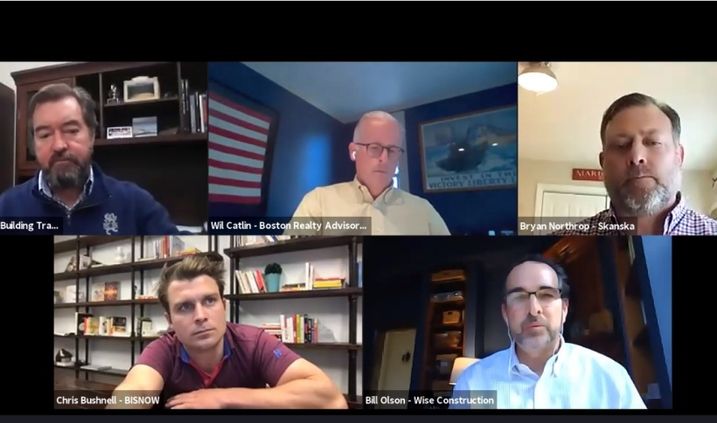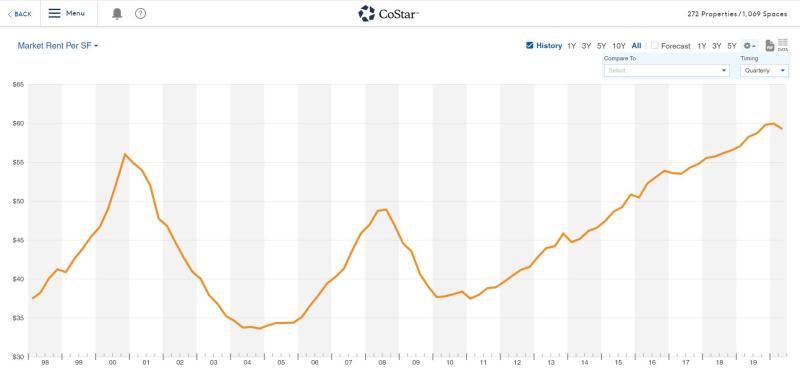
Learn more HERE.

Bisnow Tuesday, June 16 as Calare Properties CEO Bill Manley discusses how the pandemic has impacted Boston industrial and how the market will continue to grow in a post-pandemic world.
Our content will touch on:
Register HERE.

The use of transit and commuting has come to a halt since the start of the pandemic. Now, people are wondering what continued social distancing measures will mean for the future of subways and busses. How might the office community be impacted with limited commuter options moving forward? How will a lack of accessibility to the inner city impact the demand for real estate? What are transit leaders thinking about the future of transit?
Join Bisnow on June 11 along with MassDot/MBTA Chief Strategy Officer & Undersecretary Scott Bosworth, BSC Group President & CEO Sean O’Brien and Metropolitan Area Planning Council Government Affairs Director Lizzi Weyant as they discuss how the pandemic has impacted transit and their thoughts on what it could mean for the market.
Our content will touch on:
Register HERE.
The re-entry to the office for Boston Realty Advisors has begun. We require all team members and visitors to self-certify based on six questions.
We are using guidelines by the state of Massachusetts to get back to the office. Here are the ground rules:

By
The long-term outlook for affordable housing depends on its location in walkable areas with access to transit that will take residents to their jobs: urban density, in other words, or at least a pocket of density around a transit node.
The pandemic has called that model into question, but in the long run, urban density will be resilient, Stantec Architecture Senior Associate Aeron Hodges said.
“One of the most frequent responses to the situation has been an aversion to density and urbanity, for understandable reasons,” Hodges said during Bisnow’s Re-Imagine Housing Affordability in a Post-Pandemic Boston webinar last week. “But cities will bounce back quickly, partly because of the infrastructure that is already in place.
“Humans are social creatures,” she added. “We’re drawn to each other. Density creates an energy chamber for innovation, for ideas that we are so much in need of.”
Transit will remain vital to the future of affordable housing, said Wandy Pascoal, the housing innovation design fellow for the Boston Society for Architecture and the city of Boston. Not just to provide access to employment and services, but as a factor in allowing more units in the same space.

“A relatively small chunk of the cost can be lowered if we reduce the amount of parking that’s available, increasing the number of units that get built out,” she said. “That means for the overall development project, there is a reduced cost per unit.”
Reducing parking will also make Boston a more livable and walkable city, Pascoal said.

The speakers also said that effective development of affordable housing in Boston will depend on smaller unit sizes.
“Even before the pandemic, one of the things we were focusing on was compact living,” Hodges said. “It’s the idea of living small and sharing more. It’s not a typology for everybody, but there’s a huge demand for it among young people trying to land on their feet in the city.”
Both Pascoal and Hodges were involved with the recent Urban Housing Unit Roadshow, when a prototype of a 385 SF residential apartment was shown in six different Boston neighborhoods to receive input from the communities.
On the whole, they said input was positive, since the concept represents an opportunity to downsize and streamline one’s lifestyle in an affordable way, since as modular units, UHUs would be less expensive to build.
Young people were interested, but so were those looking to downsize after raising a family, Pascoal said.
“I met a 65-year-old from Roxbury who was enthusiastic about leaving her three-story Victorian house,” she said.
The speakers said that Boston could learn from small-unit designs in other parts of the world.
In Barcelona, for example, La Borda is a housing cooperative on public land, with a leasehold of 75 years. Built of cross-laminated timber around an atrium, which provides access to natural air, its units of about 450 SF rent for less than €800, much less than the city’s average, Pascoal said.

Moderated by Wil Catlin (Boston Realty Advisors) with a star-studded panel, including Michael Maturo (RXR Realty); Matthew Friedman (Rockwood Capital); Arthur Jones (Principal Real Estate Investors); and Robert Deckey (Invesco US)
iGlobal Forum Live introduces a brand-new virtual event, providing you with key insights into the Offices market.
This 1-hour discussion is the perfect opportunity to delve into this key commercial real estate sector with industry leaders, both from asset management and acquisition standpoints, enabling you to get solutions you can take back and use in real time.
Key topics include:
Register HERE.
Boston officials have pledged $6 million in grants to support small businesses where employees must work in close proximity with either coworkers or customers — such as hair salons and barber shops, retail stores, gyms and food service establishments — to provide personal protective equipment so those businesses can reopen.
Companies with fewer than 15 employees can apply for up to $2,000 for materials such as masks and safety partitions for customers and employees. The funding will be available in three rounds: first, for personal services including barber shops and hair salons; second, for retail, restaurants, nail salons, day spas, waxing and laser services; and third, for bars, arts and entertainment venues and fitness businesses.
Applications open Thursday at 5:00 p.m. at boston.gov/reopen-fund.
“When our small businesses are ready and able to open, we want our business owners and workers to have access to the appropriate resources to stay safe,” Boston Mayor Marty Walsh said in a statement. “These additional grants will help level the playing field for Boston’s small businesses and support both our public health and economic equity priorities.”
At a press conference on Tuesday, Walsh stressed that employees should continue to work from home if possible. Workers should not feel pressured to come into work if they don’t feel safe, he said.
“We have to do our part to minimize the risk of another surge,” he said. “It’s not the time to let up.”

Like many cities today, Boston has a shortage of affordable housing. Along with that, the Boston population is expanding significantly faster than housing can be built. What will this mean Bostantonians long term?
Solutions for limited space, reducing project expenses and expediting the preconstruction process all come down to the initial design phase.
Design leaders are approaching policy, incorporating technology to expedite permitting and utilizing space to build smaller units at volume more than every.
Join Bisnow May 26 for a deep dive into how leaders and designers plan to usher in a new and more affordable era through design in Boston CRE.
There will be plenty of time for questions.
If you can’t attend live, register. We will be sending the recording to all registrants.
During this webinar we will discuss:
–What innovative design solutions can reduce housing expenses?
–How do high-density housing models present new opportunities for housing expenses in Boston today?
–How changes in design policy can facilitate new support systems in the inner city?
–What are new ways to approach the limitations of land and build space in downtown Boston?
–How technology is being used to change the design process and eliminate delays that increase development cost?
Register HERE.

By Drees Stribling | Bisnow | May 19, 2020
As the construction industry in Boston is poised to reopen completely, the challenge of operating efficiently while social distancing are only going to intensify, experts said this week.
According to the speakers at Bisnow’s recent webinar, How to Get Boston Construction Back Underway, it has already been a struggle.
A lot of construction deemed essential didn’t stop over the last two months, giving construction companies time to start screening and to improve the process, Skanska Executive Vice President and General Manager Bryan Northrop said.
“People want to feel comfortable with their surroundings,” he said. “We’ve been doing the checks and the self-certifications, and we’ve taken a step further to try to automate [the process], so you don’t have to handle pens and paper.”
“What we’re finding is all the folks working on the job site support this, and we haven’t had any pushback. I think everyone understand it’s not only for their well-being, but their co-workers,'” Northrop said.
Skanska began checking temperatures with handheld units, and some jobs sites have stand-mounted devices that workers can walk by, Northrop said. He added that it is important to note that the results of the screening, including the answers to questions about worker health, are kept confidential.
Wise Construction Director of Construction Bill Olson said going paperless is important for privacy, but also because the goal is to not have people touch anything that isn’t theirs to begin with.
“There’s a lot of promising technology out there that people are starting to explore,” he said, citing one system that counts the number of people at a job site.
“We’re trying to limit a job site to 500 SF per person, so we count workers as they come to a job site, and we know when they get to that limit,” Olson said. “Our focus is individual safety. If each worker on our site can protect [him or herself] and others, we have the baseline safety.”
Another challenge for the industry are the costs associated with screening and social distancing, the speakers said. Some costs are more obvious than others, such as the expense associated with testing equipment and personal protective equipment.
“There are cost increases, and we’ve had clients ask us about what to expect, and frankly, each answer is different, because each job is in a different place,” Northrop said.
In high-rise construction, vertical transportation is a critical factor in efficiency, and social distancing has had an impact on how efficiently it can be used, Northrop said. The industry is working on ways to adjust to that reality, such as staggering shifts, but it is going to be an ongoing challenge.
Screening workers and limiting their numbers on-site is only the beginning, the webinar participants said.
“When you think about the complexities of what you’re doing, [like] hanging sheetrock or glass, how do you separate each other?” asked Boston Realty Advisors Managing Director and Senior Partner Wil Catlin, who co-moderated the event.
Construction workers are used to working shoulder-to-shoulder to complete tasks, so social distancing is a different way to work, and certainly a challenge, Northrop said. But when workers in the trades are challenged, they come up with creative ideas.
Sometime designers have modified aspects of a building’s plan, such as panel sizes, to help make it easier to do while at a distance, he said. But some tasks can’t be done while social distancing.
“When you start getting within 6 feet, and there’s no other way, we start putting people in more substantial respirators or face shields,” Northrop said.
Pandemic-era safety measures might seem like a strange new normal for the construction industry, but worker safety has long been a focus in the industry. The pandemic adds a layer of complexity to worker safety that will take some getting used to, speakers said, even with enhanced training.
“We all want to get back to work, but we want to get back to work as safely as possible,” Massachusetts Building Trades Council Executive Vice President Francis Callahan Jr. said. “Safety is job one.”
Safety at jobs sites now begins with the basics, including checking temperatures. That is only a first step, because some carriers of COVID-19 can be asymptomatic or have other symptoms besides fever. Construction sites also need to know whether workers have been traveling recently, whether they have been exposed to anyone with the disease, or if they have lesser-known symptoms, such as a loss of smell and taste.
“It’s important that we get this right the first time,” Callahan said. “We don’t want everybody going back to work, and we have a spike and have to shut down again.”
Callahan pointed out that construction unions are shouldering much of the costs for online training, which is a critical factor in making the new safety procedures work.
“That’s our focus, and that’s how we’re addressing our safety needs,” he said. “Our members are going to show up at the job site, as they always do, with a much higher level of training.”

By Tim Logan | Boston Globe | May 6, 2020

Rents for office space in downtown Boston could fall sharply this year as companies lay off employees and reassess how and where they work amid the coronavirus outbreak, according to a report out Wednesday.
Estimates from Moody’s Analytics project a 12 percent drop in office rents in the city, one of the five steepest declines in the country, as the impact of the pandemic sweeps through the economy, and particularly through dense downtown business districts like Boston’s.
It would mark the end of a long run-up in rents and demand for office space in central Boston, though the study’s author, Victor Canalog, noted a 12 percent drop would be softer than the crashes of the early 1990s and 2001, and about what the region endured amid the broad economic collapse in 2008 and 2009.
In that context — and given the cratering economy and job market — things could look a lot worse, he said.
“This is the world we live in right now,” said Canalog, who is head of commercial real estate economics at Moody’s. “If we say ‘It’s going to be about as bad as 2008 and 2009,’ that’s actually a good thing.”
But Canalog’s report points to some troubling longer-term trends for cities such as Boston, which thrive on their busy business districts. If employers embrace work-from-home technology, they may ultimately decide they need less office space in general. If, at the same time, they decide they need to spread out workers who do come into the office, it may make sense to relocate to suburban office parks where rents are typically far lower.
“If it’s true that we’re going to reduce footprint, then there are going to be winners and losers,” Canalog said. “A company might not move from Boston to North Dakota. There are good reasons they want to be near Boston. But they might move out of downtown Boston to someplace 20 miles away, where they can get many of the same things.”
But those are longer-term decisions. At the moment, seven weeks into a public health emergency that has shut down big swaths of the region’s economy, the impact on Boston’s office market has been muted.
Few new leases have been signed, in part due to the complications of touring and inspecting space, and also because of the broader economic uncertainty. Several large deals in downtown office towers reportedly nearing completion have been put on hold, or scuttled, while companies reassess the market.
But no companies have publicly backed away from signed deals to move in the next couple of years. Some tenants, particularly in tech and life sciences, continue to look for space. And developers with large towers under construction say they still plan to deliver the buildings, fully leased, if perhaps a bit delayed by construction shutdowns.
So far, building owners have been reluctant to lower rents to lure tenants, said Mark Hickey, director of market analytics in the Boston office of Costar, a real estate data firm. Instead they’re offering more concessions or longer-term leases.
But it appears they could face competition from a growing inventory of sublease space, particularly from tech companies that in recent years gobbled up large blocks of office space for future growth, which they may no longer need and may put out for lease at a discount. The real estate firm Colliers estimates there was 1.6 million square feet of sublease space on the market at the end of April, more than Boston had during the real estate crash of 2009.
Even aside from questions of supply and demand, this experience is likely to change how companies view and use office space, said Aaron Jodka, managing director of research at the Boston office of the real estate firm Colliers. The question is how.
“Do tenants need more space because of distancing requirements? Or less space, because more people are working from home?” he said. “I don’t know. It’s too soon to tell.”